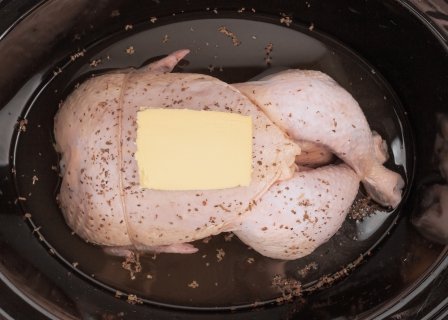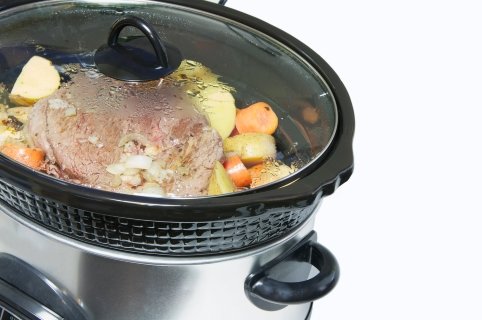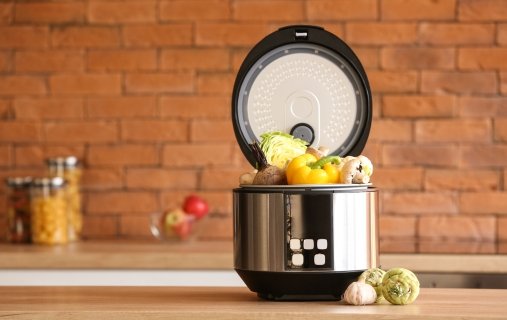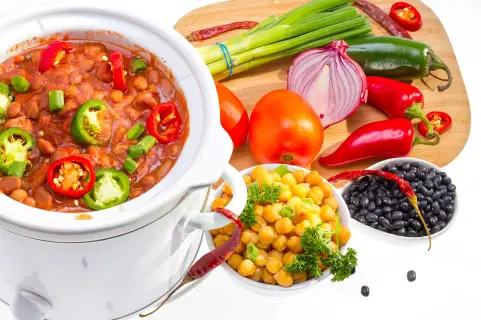Once you get used to cooking food in a slow cooker, there is no going back. The fact that you do not have to attend to or keep stirring the pot constantly is nothing short of a blessing. Slow cookers have added convenience to the cooking experience, as you can simply add the ingredients and leave the pot on for hours. Now the question arises: How long can you leave a slow cooker on low? Typically, you can keep a slow cooker on for around 6 to 10 hours, given that it is set on low.
We have compiled a detailed guide to address all your concerns regarding slow cookers and how to use them more efficiently. Keep reading to find out!
Table of Contents
- 1 Does Slow Cooking Kill Bacteria?
- 2 Can I Leave a Crockpot on Low Overnight?
- 3 Can I Leave a Slow Cooker on for 24 Hours Unattended or Will it Catch Fire?
- 4 How Long Can You Leave a Crockpot on Warm And Ensure Food Safety?
- 5 Can You Stop and Restart a Slow Cooker?
- 6 Other Precautions to Take for Slow Cooker Food Safety
- 7 Can You Cook Meat Too Long or Overcook With a Slow Cooker?
Does Slow Cooking Kill Bacteria?
Yes, if you follow proper guidelines, it is easy to kill bacteria using slow cooking. A slow cooker is used for cooking food at low heat for several hours. The direct heat from the pot and steam build-up helps destroy bacteria, making your food safe for consumption. You just have to maintain a temperature in the range of 170 to 300 degrees Fahrenheit.
Did you know that you can also boil food inside a slow cooker besides slow cooking?
Click here to read: Should My Slow Cooker Be Bubbling?
Can I Leave a Crockpot on Low Overnight?
Yes, you can leave a crockpot on low overnight. A standard crockpot is designed to slow cook food for longer durations, up to 8 to 10 hours or more, depending on what you are cooking. If you leave your crockpot on low heat settings and follow other cooking instructions, you can leave it on for the whole night and enjoy your cooked meal the next day.
This slow cooking method works best for cooking stew, broth or roasted meat. However, keep in mind that each recipe requires different ingredients and cooking time may vary based on that. Therefore, always follow recipes specifically for crockpots if you plan to leave them on overnight. Some crockpot manufacturers also have specific instructions and features, so carefully read the user manual before attempting this.
Can I Leave a Slow Cooker on for 24 Hours Unattended or Will it Catch Fire?
There are slim chances of your slow cooker catching fire if you leave it unattended for 24 hours, but that does not mean it cannot happen. If you have an old model of a slow cooker or it has a faulty component, leaving it unattended for a day is a potential fire hazard.

If you have an old, slow cooker with fabric-wrapped electric cords, it can be risky to cook food in it, as fabric cords are not in line with today’s safety standards. If you overfill your slow cooker or place it on a flammable surface, leaving it unattended for 24 hours may result in a fire accident.
To avoid such incidents, make sure that you repair or replace old crackpots. Here are some of the best slow cookers on the market today. Moreover, you could also take extra safety precautions while cooking food on a high setting or leaving it unattended for too long.
How Long Can You Leave a Crockpot on Warm And Ensure Food Safety?
You should not leave a crockpot on warm for more than 2 to 5 hours to ensure that your food is safe and healthy for consumption. While you may leave a crockpot on low settings for hours or even overnight, keeping it on warm is not recommended.
Leaving the crockpot on warm for more than 5 to 6 hours is most likely to leave your food undercooked, especially if it is protein. This could also potentially risk slow cooker food poisoning if the bacteria remain active in the meat.
Can You Stop and Restart a Slow Cooker?
Yes, you can stop and restart a slow cooker, but it is certainly not recommended. When you do that, you are at risk of undercooking the food, and it may reach the danger zone temperature. According to the USDA, the danger zone for food is 40 to 140 degrees Fahrenheit, and if your food falls in that range, it is not safe for consumption.
If necessary, you may stop and restart a slow cooker quickly as long as there is minimum temperature loss. Just keep a food thermometer handy and ensure that the food does not fall in the danger zone range.
Other Precautions to Take for Slow Cooker Food Safety
If you want to ensure that the food in your slow cooker is safe and healthy, you have to maintain the optimum cooking temperature. However, this is not the only precaution you need to ensure food safety.
Read on to find other precautionary measures that you can take to assure that your food is safe and healthy:
Do Not Remove Slow Cooker’s Lid
You should avoid removing the lid of a slow cooker. This releases all the trapped heat and moisture from inside the slow cooker, causing delays in cooking time. When you open the lid, the cooking time increases by 30 minutes and the temperature drops by 10 to 15 degrees. Therefore, keep the lid on and follow the recipe instructions to ensure that your food is cooked properly.

Defrost Your Meat Before Adding It to a Slow Cooker
If you need to cook meat in a slow cooker, make sure to defrost it first. Putting frozen meat directly in a slow cooker can disrupt the temperature inside and put you at risk of food poisoning if the meat does not get cooked on time. To defrost meat, use a microwave or place it in a zip lock bag and submerge in warm water for half an hour.
Avoid Overfilling the Slow Cooker
Ideally, it would be best if you only filled half or three-quarters of your slow cooker with the ingredients or water. Adding too many ingredients increases the cooking time, resulting in some ingredients getting burnt while others are left undercooked. To avoid this, follow the recommended settings of your slow cooker to ensure your food is neither overcooked nor undercooked.

Double-check your Slow Cooker Settings
The newer models of slow cookers come with digital temperature settings. This means that you can schedule and change your settings on the go. As a general rule of thumb, make sure that you always double-check your slow cooker settings both before and during the cooking process.
Set your slow cooker to low settings if you must leave your food unattended all day, especially when cooking protein. It is recommended to set the slow cooker to high settings for the first hour to ensure your food gets out of the danger zone i.e. the upper limit of 140 degrees Fahrenheit. Ideally, you should continue adjusting the temperature until the food reaches 165 degrees Fahrenheit within the first 2 to 3 hours of cooking.
Make sure you haven’t accidentally left the slow cooker on warm instead of low! If you find out that you’ve done that when you return home after a long day, throw the contents of the cooker out because its environment would’ve been an ideal breeding ground for bacteria.
Taking Care of Power Outages
Suppose there is an unforeseen power outage while your food is still cooking inside a slow cooker; it’s time to look for alternatives. Keeping your food inside a slow cooker in case of a power outage is not recommended as it may leave it undercooked or a breeding ground for bacteria.
Your best bet is to transfer the food to a gas stove or outdoor grill, basically anywhere else where you can continue cooking it. If you are not quick to make this switch, your food may get contaminated with bacteria. If you cannot provide any heating source for your food, it is better to throw it away and avoid the risk of getting food poisoning.
Thermometer to the Rescue
As an extra safety precaution, it is recommended that you use a cooking thermometer to keep a check on the temperature of your food. This way, you can ensure that your food is cooked to perfection, and you do not need to change or adjust your slow cooker settings again and again.
Can You Cook Meat Too Long or Overcook With a Slow Cooker?
Yes, it is possible to overcook food even with a slow cooker. This happens when you use the wrong setting or leave the food cooking for longer than mentioned in the recipe.
If meat cooks for too long, it will become dry, tough and stringy, and all of the flavor will evaporate. In addition to this, the fat may separate out from the rest of the ingredients, making food taste greasy. Therefore, it is essential to check your food often when using a slow cooker; different cuts of meat require different amounts of time to cook correctly.
To avoid overcooking food, it is advisable to follow recipes specifically for slow cookers and study your slow cooker’s user manual in detail, so you do not mess up the settings.

